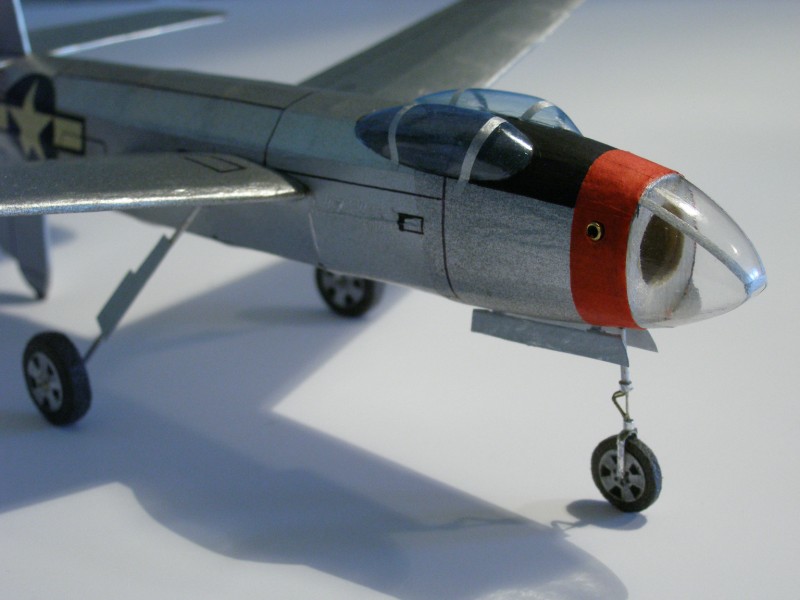Douglas XB-42 "Mixmaster"

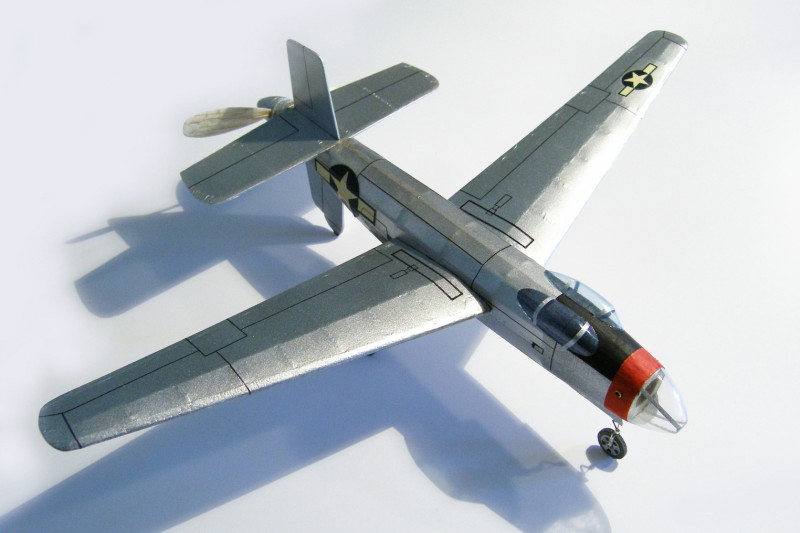
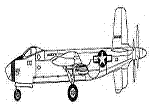 From the end of January 2007 till the end of April 2007 the Weiss Minute
Model Cookup was held on the
Small Flying Arts Forum. Builders could chose from the planes designed by
Herbert Weiss between 1938 and 1947. A choice could be made between the Brewster
Fighter (Buffalo), Curtiss XP-40, Douglas Devastator, Douglas Mixmaster,
Mauboussin Tandem, Messerschmitt 109, Nieuport 161, North American P-51, Piper
Cub and Seversky Executive. Plans can be found in the files section of
minute models group at
Yahoo.
From the end of January 2007 till the end of April 2007 the Weiss Minute
Model Cookup was held on the
Small Flying Arts Forum. Builders could chose from the planes designed by
Herbert Weiss between 1938 and 1947. A choice could be made between the Brewster
Fighter (Buffalo), Curtiss XP-40, Douglas Devastator, Douglas Mixmaster,
Mauboussin Tandem, Messerschmitt 109, Nieuport 161, North American P-51, Piper
Cub and Seversky Executive. Plans can be found in the files section of
minute models group at
Yahoo.
My choice was the Douglas XB-42 "Mixmaster," a high-speed bomber developed in 1943 but never put into production. The design had rear mounted contra-rotating propellers, each powered by its own engine. This aircraft was designed for a crew of three: a pilot and co-pilot in separate side-by-side canopies, and a navigator/bombardier in the glazed nose section
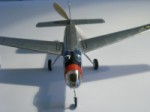 Modifications
Modifications
I started by studying the plan carefully and discovered a few things which I wanted to change:
- The wing spar runs right through the fuselage where the rubber should be free to vibrate. I decided to mount the wings flush on the fuselage.
- The exact location of the stabilizer is not shown on the plan, so I placed it between the upper keel and the upper stringer.
- The all sheet tail surfaces would probably result in a tail heavy model, which requires a lot of nose weight. I decided to build up tail surfaces to keep the tail as light as possible.
- The front can be strengthened by sheeting the first bay. Extra weight in the nose will be needed anyway!
- The wings of on the plan are shorter than they should be when compared to 3-views of the real thing. I know these Minute Models aren't exact scale models, but if I can get better performance by making it more to scale it seems to be a good idea. Therefore I added about 3 centimeters to each wing.
- The airfoil is semi-symmetrical, but I decided to use a flat bottomed airfoil to make building a lot easier.
- There is no decalage (incidence difference between wing and stab) indicated on the plan. I chose to build the wing at 0 degrees relative to the fuse axis, and the stab at minus 3 degrees. The thrustline was changed to have 4 degrees down and 3 degrees left. I hope these settings will be OK for flying!
I think this model was designed with static display in mind, not to be flown. If someone knows of a flying model built from this plan, please let me know!
Construction
I started by building the fuse. The keels were pinned on the building board, and the formers were attached using with UHU Hart (equivalent to Duco or Ambroid). To support the fuse during assembly, a temporary scaffolding was built - two parallel strips were placed alongside the keels, and cross pieces were glued to both the keels and the parallel strips (this time using PVA glue). This created a ladder-like supporting frame which kept everything aligned while formers and stringers were added.
The assembly was then removed from the building board (keeping the scaffolding attached), and the other half of the formers and stringers were added. By soaking in water, the scaffolding was easily removed without affecting the UHU Hart glue joints in the fuse. The result was a nice, straight fuse.
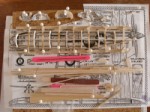 |
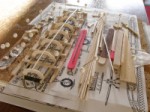 |
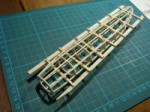 |
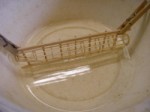 |
To mount the stabilizer I had to remove the upper keel. To prevent the fuselage from distorting I added two diagonal stringers inside the fuse, at the bottom-rear. This guarantees that the incidence of the stabilizer and the downthrust will not change in time.
I made a solid balsa nose cone for vacuum forming a the glazed nose section. Luckily I was able to use the cockpit plug from my pistachio Baxter Mustang to make the twin cockpits. Wheels were made from black depron, on which I glued printed wheel rims.
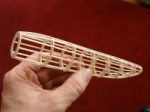 |
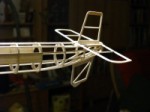 |
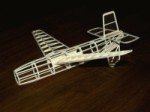 |
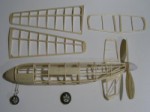 |
I made the prop blades for the "flying prop" as shown on the plan. It is paddle style, using sheet balsa on tooth pick spars. The tooth picks fit into a plastic tube so the pitch can be adjusted, and pitch is oriented so that I can use my winder without having to wind backwards.
I think the flying prop was not meant to be used with a spinner, which is only shown on the static display prop. But I think it deserves a spinner in flight because it is an important characteristic part of this plane. Blue foam was used here to save weight. Inside the spinner I made a ramp style freewheel mechanism, as shown on the left. In Dutch, “ramp” means disaster... I hope this is not an omen!
The prop and tail block weigh about 1 gram.
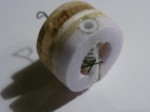 |
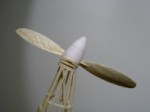 |
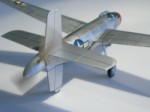 |
Covering
I covered the wings and front of the fuse with black esaki. The rear of the fuse and tail surfaces were covered with condensor paper to minimize weight. I sprayed the covered parts using a can of silver acrylic car rim spray. After spraying I put on all panel lines as indicated in a 3-view.
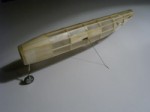 |
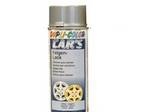 |
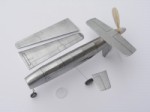 |
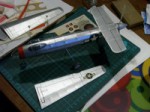 |
The rubber motor mount in the front is made from brass tube to add some weight. In spite of all my efforts, 1 gram of noseweight was needed to get the balance at 40% of the root chord, which was the calculated optimum position of the Centre of Gravity.
Flying
The Mixmaster flies on a loop of 2 mm (3/32") rubber. This motor can take 1100 turns, but I limit this to 900 for most flights. The prop has a few degrees downthrust, no side thrust is needed. A trimtab on the right wing counteracts the torque reaction from the counter clockwise turning prop. Three degrees incidence difference wasn't sufficient, I had to add a 1.5 mm shim beneath the TE of the stab. Using these settings the model flies 35 second flights. This will be increased in the future by using a longer motor. Flights of 30 seconds aren't bad for such a model, especially because this is the only flying model build from this plan. Or isn't it? If someone knows of another flying Weiss Mixmaster, please let me know!
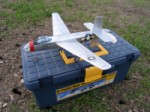 |
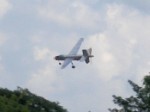 |
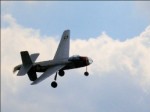 |
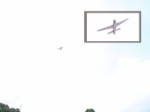 |
